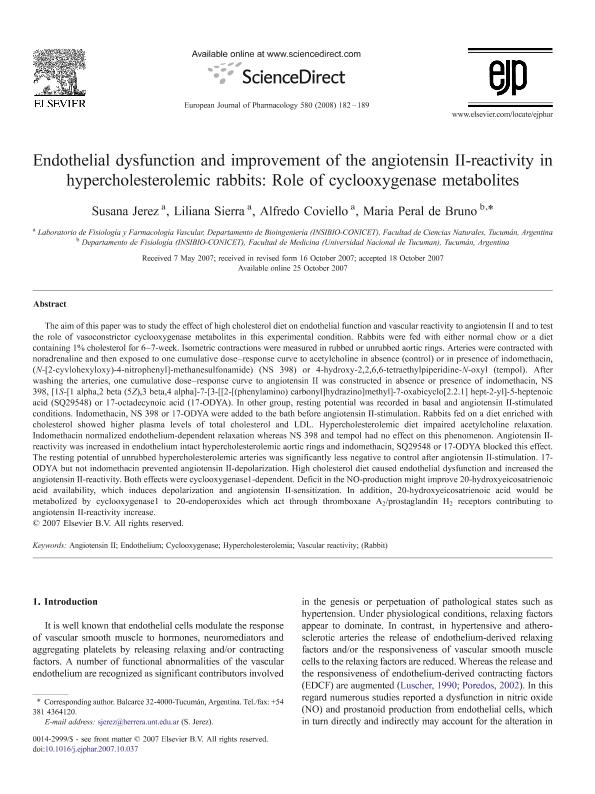Mostrar el registro sencillo del ítem
dc.contributor.author
Jerez, Susana Josefina

dc.contributor.author
Sierra, Liliana Beatríz

dc.contributor.author
Coviello, Alfredo

dc.contributor.author
Peral, Maria de Los Angeles

dc.date.available
2018-12-05T19:33:48Z
dc.date.issued
2008-02
dc.identifier.citation
Jerez, Susana Josefina; Sierra, Liliana Beatríz; Coviello, Alfredo; Peral, Maria de Los Angeles; Endothelial dysfunction and improvement of the angiotensin II-reactivity in hypercholesterolemic rabbits: Role of cyclooxygenase metabolites; Elsevier Science; European Journal of Pharmacology; 580; 1-2; 2-2008; 182-189
dc.identifier.issn
0014-2999
dc.identifier.uri
http://hdl.handle.net/11336/65926
dc.description.abstract
The aim of this paper was to study the effect of high cholesterol diet on endothelial function and vascular reactivity to angiotensin II and to test the role of vasoconstrictor cyclooxygenase metabolites in this experimental condition. Rabbits were fed with either normal chow or a diet containing 1% cholesterol for 6-7-week. Isometric contractions were measured in rubbed or unrubbed aortic rings. Arteries were contracted with noradrenaline and then exposed to one cumulative dose-response curve to acetylcholine in absence (control) or in presence of indomethacin, (N-[2-cyvlohexyloxy)-4-nitrophenyl]-methanesulfonamide) (NS 398) or 4-hydroxy-2,2,6,6-tetraethylpiperidine-N-oxyl (tempol). After washing the arteries, one cumulative dose-response curve to angiotensin II was constructed in absence or presence of indomethacin, NS 398, [1S-[1 alpha,2 beta (5Z),3 beta,4 alpha]-7-[3-[[2-[(phenylamino) carbonyl]hydrazino]methyl]-7-oxabicyclo[2.2.1] hept-2-yl]-5-heptenoic acid (SQ29548) or 17-octadecynoic acid (17-ODYA). In other group, resting potential was recorded in basal and angiotensin II-stimulated conditions. Indomethacin, NS 398 or 17-ODYA were added to the bath before angiotensin II-stimulation. Rabbits fed on a diet enriched with cholesterol showed higher plasma levels of total cholesterol and LDL. Hypercholesterolemic diet impaired acetylcholine relaxation. Indomethacin normalized endothelium-dependent relaxation whereas NS 398 and tempol had no effect on this phenomenon. Angiotensin II-reactivity was increased in endothelium intact hypercholesterolemic aortic rings and indomethacin, SQ29548 or 17-ODYA blocked this effect. The resting potential of unrubbed hypercholesterolemic arteries was significantly less negative to control after angiotensin II-stimulation. 17-ODYA but not indomethacin prevented angiotensin II-depolarization. High cholesterol diet caused endothelial dysfunction and increased the angiotensin II-reactivity. Both effects were cyclooxygenase1-dependent. Deficit in the NO-production might improve 20-hydroxyeicosatrienoic acid availability, which induces depolarization and angiotensin II-sensitization. In addition, 20-hydroxyeicosatrienoic acid would be metabolized by cyclooxygenase1 to 20-endoperoxides which act through thromboxane A2/prostaglandin H2 receptors contributing to angiotensin II-reactivity increase.
dc.format
application/pdf
dc.language.iso
eng
dc.publisher
Elsevier Science

dc.rights
info:eu-repo/semantics/openAccess
dc.rights.uri
https://creativecommons.org/licenses/by-nc-sa/2.5/ar/
dc.subject
(Rabbit)
dc.subject
Angiotensin Ii
dc.subject
Cyclooxygenase
dc.subject
Endothelium
dc.subject
Hypercholesterolemia
dc.subject
Vascular Reactivity
dc.subject.classification
Farmacología y Farmacia

dc.subject.classification
Medicina Básica

dc.subject.classification
CIENCIAS MÉDICAS Y DE LA SALUD

dc.title
Endothelial dysfunction and improvement of the angiotensin II-reactivity in hypercholesterolemic rabbits: Role of cyclooxygenase metabolites
dc.type
info:eu-repo/semantics/article
dc.type
info:ar-repo/semantics/artículo
dc.type
info:eu-repo/semantics/publishedVersion
dc.date.updated
2018-11-13T14:04:37Z
dc.journal.volume
580
dc.journal.number
1-2
dc.journal.pagination
182-189
dc.journal.pais
Países Bajos

dc.journal.ciudad
Amsterdam
dc.description.fil
Fil: Jerez, Susana Josefina. Consejo Nacional de Investigaciones Científicas y Técnicas. Centro Científico Tecnológico Conicet - Tucumán. Instituto Superior de Investigaciones Biológicas. Universidad Nacional de Tucumán. Instituto Superior de Investigaciones Biológicas; Argentina
dc.description.fil
Fil: Sierra, Liliana Beatríz. Consejo Nacional de Investigaciones Científicas y Técnicas. Centro Científico Tecnológico Conicet - Tucumán. Instituto Superior de Investigaciones Biológicas. Universidad Nacional de Tucumán. Instituto Superior de Investigaciones Biológicas; Argentina
dc.description.fil
Fil: Coviello, Alfredo. Consejo Nacional de Investigaciones Científicas y Técnicas. Centro Científico Tecnológico Conicet - Tucumán. Instituto Superior de Investigaciones Biológicas. Universidad Nacional de Tucumán. Instituto Superior de Investigaciones Biológicas; Argentina
dc.description.fil
Fil: Peral, Maria de Los Angeles. Consejo Nacional de Investigaciones Científicas y Técnicas. Centro Científico Tecnológico Conicet - Tucumán. Instituto Superior de Investigaciones Biológicas. Universidad Nacional de Tucumán. Instituto Superior de Investigaciones Biológicas; Argentina
dc.journal.title
European Journal of Pharmacology

dc.relation.alternativeid
info:eu-repo/semantics/altIdentifier/doi/https://dx.doi.org/10.1016/j.ejphar.2007.10.037
dc.relation.alternativeid
info:eu-repo/semantics/altIdentifier/url/https://www.sciencedirect.com/science/article/pii/S0014299907012095
Archivos asociados
